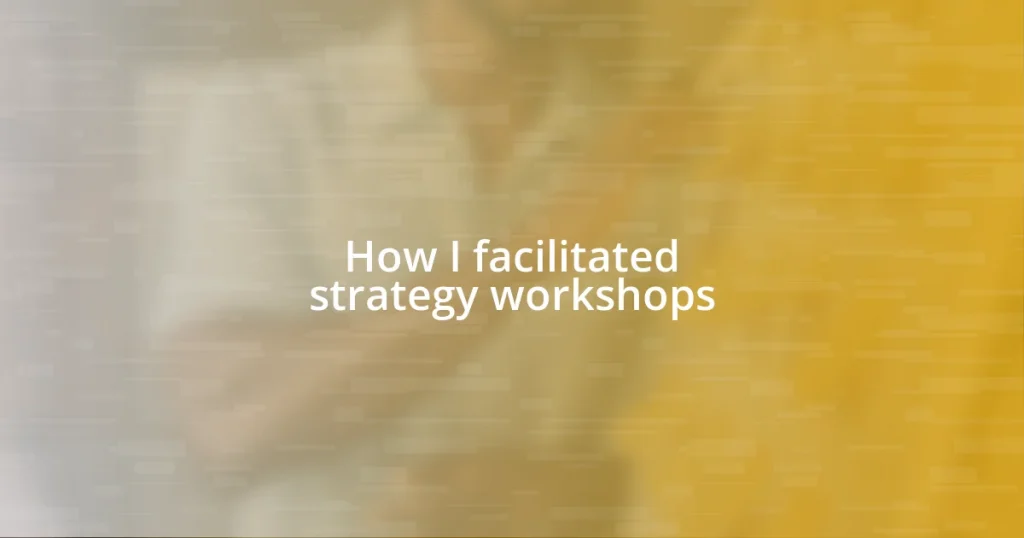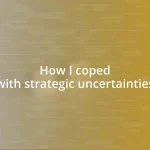Key takeaways:
- Effective strategy workshops define clear, specific, measurable objectives, fostering ownership and alignment among participants.
- Engaging participants through inviting atmospheres, breakout sessions, and real-time feedback enhances collaboration and idea sharing.
- Analyzing feedback post-workshop and implementing insights into action, such as accountability groups, ensures continuous improvement and tangible outcomes.

Understanding strategy workshops
Strategy workshops serve as a powerful platform for organizations to define their direction and make sense of complex challenges. I remember the first time I facilitated one; it felt like unlocking a treasure chest of ideas and perspectives. Everyone came in with different viewpoints, but by the end, we had forged a cohesive strategy that truly reflected our collective vision.
These workshops aren’t just about the mechanics of planning; they’re deeply emotional spaces where participants can voice their dreams and apprehensions. Have you ever been in a room where everyone’s on the same page? It’s exhilarating! The energy shifts when team members realize they share the same goals, and it’s that synergy that drives innovation and commitment.
Ultimately, a well-facilitated workshop encourages trust and collaboration, transforming individual contributors into a united front. From my experience, it’s about guiding discussions that can be uncomfortable, yet necessary. How do we address the doubts lingering in the corners of our minds? By providing a safe space where everyone feels valued and heard, we create an environment ripe for creativity and strategic breakthroughs.

Defining clear objectives
Defining clear objectives is crucial in any strategy workshop. I once worked with a team that struggled with vague, overarching goals, resulting in an unfocused discussion. We took a step back and decided to articulate several specific, measurable objectives. This process sparked renewed energy in the room. Suddenly, participants felt empowered to contribute ideas that aligned with our newly defined targets.
To ensure objectives are effective, I always emphasize these key points:
- Specificity: Each objective should clearly outline what we aim to achieve.
- Measurable: It’s essential to determine how we will track progress and success.
- Alignment: Objectives must resonate with the broader vision of the organization.
- Inclusivity: Involve all participants to ensure diverse input and buy-in.
- Time-bound: Setting deadlines helps maintain focus and accountability.
By focusing on well-defined objectives, I find that the conversation flows more purposefully, creating a sense of collective ownership that is both motivating and inspiring.

Crafting an effective agenda
When crafting an effective agenda for a strategy workshop, I always start by considering the specific outcomes I want to achieve. For instance, during a recent workshop that I facilitated, we outlined each session’s primary focus to ensure participants felt connected to the flow of the day. I remember one participant mentioning how much more engaged they felt as we moved through the set topics one by one, rather than getting lost in random discussions. It’s amazing how clarity in structure can enhance engagement.
Another key point is the balance between detailed planning and flexibility. I’ve encountered situations where sticking rigidly to an agenda stifles the natural flow of conversation. For example, when a lively debate emerged unexpectedly in a workshop, I chose to extend that discussion, much to the delight of the team. Allowing some organic development while having a solid foundation keeps everyone aligned and energized.
Lastly, incorporating breaks and reflections into the agenda can positively impact the workshop’s effectiveness. I recall one particularly long session where participants seemed fatigued. After a quick break, I introduced a reflection activity that rejuvenated the room. Participants shared their thoughts informally, which not only allowed them to digest the content but also fostered deeper connections. Balancing structure with moments of reflection creates an environment that breeds creativity and collaboration.
| Agenda Element | Description |
|---|---|
| Specific Focus | Clearly outline each session’s main goal to enhance engagement. |
| Flexibility | Maintain room for organic conversations that can deepen insights. |
| Breaks and Reflections | Incorporate pauses for participants to digest information and connect. |

Engaging participants effectively
When it comes to engaging participants effectively, I find that creating an inviting atmosphere is essential. I often start workshops with icebreakers that are fun yet relevant, which help participants feel at ease and build rapport. For example, in one workshop, I asked each participant to share their favorite work-related story. The laughter and camaraderie that followed transformed the energy in the room, making it easier for everyone to share ideas later on. Isn’t it amazing how a simple story can break down barriers and open the floor for collaboration?
Another effective strategy I employ is encouraging active participation through breakout sessions. I distinctly remember a workshop where I divided the participants into small groups to tackle specific challenges. It was fascinating to watch them bloom as they engaged in spirited discussions. I noticed that shyness faded away, and ideas flew freely. Those smaller settings allow quieter voices to emerge, making the workshop feel more inclusive. Who doesn’t appreciate being heard, right?
I also incorporate real-time feedback mechanisms throughout the sessions. Using tools like sticky notes or digital polling, I’ve found that participants appreciate being able to express their thoughts instantly. During a particularly dynamic workshop, I utilized a digital board where participants could post questions or comments anonymously. The result was remarkable—people shared concerns they might not have voiced otherwise. The insights gained from this feedback were invaluable and often led to deeper discussions, ultimately refining our strategies. Engaging participants in this way not only fosters a rich dialogue but also reinforces a sense of belonging and purpose within the group.

Utilizing collaborative tools
Utilizing collaborative tools has dramatically enhanced my strategy workshops. For instance, I often use digital whiteboards to capture ideas in real-time. One time, during a brainstorming session, I saw participants rallying around a shared vision as they scribbled down thoughts, making it feel like a collective creation. It was electrifying to witness the synergy as we built upon each other’s ideas right there on the screen. Doesn’t it feel great when technology acts as a bridge between minds?
In addition, I’ve found that employing polling tools keeps everyone engaged and on their toes. During a recent workshop, I conducted quick polls to gauge opinions on specific strategies. The immediate feedback was not only enlightening, but it also sparked spirited discussions. Participants loved knowing their voices were heard instantly, and I could see the light in their eyes as they actively contributed to the conversation. Who doesn’t appreciate a chance to weigh in on important decisions, right?
I also like to incorporate collaborative document tools that allow participants to contribute to shared agendas or notes. I distinctly remember a workshop where we collectively outlined our goals on a shared document. As I watched everyone type away, it became clear that they felt ownership over their contributions. The energy in the room shifted from passive listening to active involvement. It’s fascinating how shared ownership can transform dynamics in a workshop—have you ever noticed how people light up when they become co-creators of the process?

Analyzing outcomes and feedback
Analyzing outcomes and feedback is crucial for understanding the effectiveness of my workshops. After each session, I take the time to review participant feedback meticulously. For example, during one workshop, feedback revealed that some participants found certain activities overly complex while others craved more challenge. It’s like a treasure map that points me towards areas of improvement and inspiration for future sessions. How rewarding it is to gather insights that can shape my approach!
I often employ post-workshop surveys for a deeper dive into the participants’ experiences. I remember one particular survey where a few respondents expressed that they felt overwhelmed by the pace of information. Their honesty pushed me to reflect on my facilitation style and adapt future workshops to create a more balanced rhythm. Isn’t it interesting how constructive criticism can lead to growth? It’s a reminder that there’s always room for evolution in our methods.
In addition, I find it beneficial to conduct follow-up discussions with select participants. During one such conversation, a participant shared how a specific brainstorming technique had genuinely sparked a new initiative at their workplace. Hearing how my workshop influenced their actions was incredibly fulfilling. Engaging with feedback this way not only validates my efforts but also strengthens relationships with participants—doesn’t that feel like the cherry on top?

Implementing insights into action
Implementing insights into action is where the real magic happens. I vividly remember a workshop where we identified a key strategy for improving team communication. After the session, I felt a surge of excitement when participants took those insights and immediately began drafting a communication plan. Watching them transform ideas into actionable steps was incredibly rewarding. Isn’t it inspiring when a concept evolves from mere discussion into a tangible blueprint for change?
One of the strategies I’ve found particularly effective is establishing accountability groups. In one workshop, attendees really lit up at the thought of checking in with each other regularly to monitor progress. They set a timeline to reconnect in one month, and seeing their enthusiasm made it clear that they were invested in turning their ideas into reality. Isn’t it fascinating how a simple commitment can drive action?
I also encourage participants to share their action plans with the entire group. I recall a participant who presented an innovative approach to streamlining processes; the room erupted in applause. This moment didn’t just celebrate success but also encouraged others to take similar steps. It’s astonishing how sharing can create a ripple effect, inspiring everyone involved. Have you ever noticed how a single idea can ignite a chain reaction in a group, pushing them towards collective action?















